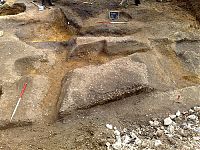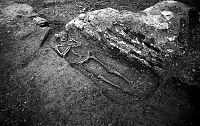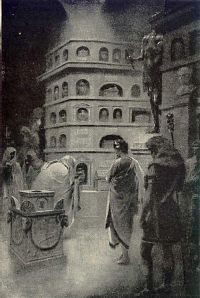A Strange and Wonderful City...
- By: Guy Hunt |
- Aug 29, 2008
- Share
- del.icio.us

As you will know if you have been following the journal, Will has been excavating a real life Roman building. I am very excited about this as it is the first Roman building I have ever found. OK, maybe that’s a bit of an exaggeration, I mean I have dug on a couple of villas and at the wonderful site of Volubilis in Morocco, but this is the first building that I ever found. Funny how we want to lay claim to something so old and (financially) worthless. At least now when I am asked “what is the best thing you ever found” I will have a good clear answer…
Firstly, a few words on the process of discovery which was not in itself painless. Will recorded our mood swings from ditches to building and back again, which is a right and proper part of the archaeological process. Obviously when we dig, we are interpreting all the time and undoubtedly our subjective opinion of what we are digging will impact on what we find. We can try to make our work objective by using pro-forma sheets and systemised recording methodologies, but, ultimately, a huge part of the interpretation and understanding of the site rests with the excavator. Luckily for us, Will did a fantastic job and he unraveled the stratigraphy of the building with great care, open-mindedness and precision. The building itself has been truncated in two ways. Firstly, it was sliced across by a (probably 18th century) drain, which cut across the central floor, through the north and the south walls then, just to add insult to injury, it was cut almost in half diagonally by a Victorian building which removed the west end of the building. What survives is a decent chunk of a rammed gravel (metalled) floor surrounded by 3 walls. Essentially, what we have is a small building measuring 2m x 2m internally, with a nice gravel floor. The lack of rubble and plaster in the foundations suggests either very thorough robbing or a timber construction. There is no evidence for either a door or a roof although it could have had both.
There was no evidence for a burial at the centre of the building, and so the building is probably best categorised as some kind of funerary building like a columbarium containing the remains of many cremated individuals, or perhaps an Altar Tomb which once contained the remains of a single individual in some kind of above ground structure (either urn or sarcophagus). It is also possible that the building also served some other function within the cemetery. These buildings are still quite a rarity, with only 7 known from the Eastern Roman Cemetery (so far…), but are well documented around the Roman world, with fine intact examples from Rome and Pompeii, to name just two.
The variety of burial types in the Eastern Cemetery is truly amazing. We have cremations in urns, boxes and bags; associated with other burials and on their own; we have inhumation burials in all positions and alignments, East-West, West-East, North-South, South-North, and also slight variations of axis within these alignments; we have wooden coffins, lead coffins, stone coffins and shrouds; we have a wide variety of different grave goods and some graves with no grave goods; most often the burials are lying on their backs, but we have prone burials and crouched burials and all of this is just the ‘normal’ stuff. Gary has blogged about a shroud burial that was weighted down with stones on the knees and Fergal has been digging a burial that was disturbed and replaced in the grave (if a little wonky). Best of all we now have our very own columbarium or altar tomb.
This diversity in burial practice can be interpreted in many ways but probably it represents a range of different social and economic status as well as a mix of different beliefs and ethnic backgrounds. Of course there is also that classic pitfall of fancy interpretations, chronology. The exact date and sequence of the burials is critical to understanding if these diverse burials are contemporary, or if burial practice changed through time.
To me, the variety of burial practice seems to represent the great diversity of Roman religious belief which permitted space for a whole pantheon of gods. Roman London must have been home to a strange variety of people from all over the Roman Empire. This would have included members of the Roman aristocratic families sent here to run the province of Britain: the Governor, Procurator and other high ranking officials as well as their families. There would have been large numbers of merchants of various types and their families who could have been from almost anywhere in the Empire. The population would of course have included a high number of military officials and soldiers. Britain was categorised by the Romans as an uncivilized province under military control or occupation. London was not perhaps as military in nature as other Roman towns in Britain such as York or Chester, but there would definitely have been a military bias in the population. As well as the officials and legionaries, there would have been large numbers of auxilliary troops from all over the empire from Morocco in the West to Persia in the East. Let us not forget the native or indigenous British population too. The population of the city which might have been as much as 50 or 60,000 would have included a large number of native Britons who had adopted Roman ways of life. All of these people brought with them practices and beliefs and many Romans adopted gods and beliefs from other places. What we seem to have in the cemeteries of London is the concrete expression of this mix.
As an archaeologist it is practically impossible to ‘prove’ what anyone in the past believed or what they thought of their own ethnic background. As a Londoner, it is humbling to look at the way the Roman city worked as a social unit, how this city was created and grew responding to the demands of its inhabitants. The things the Romans are famous for (drains, roads, aqueducts and the ability to beat up everyone in the known world) are the things that least interest me about Roman London. I find it fascinating to think of the people who lived here and the city they built. Out here at the edge of the Empire, a strange and wonderful city was being founded. Now all we have to do is dig it up…


